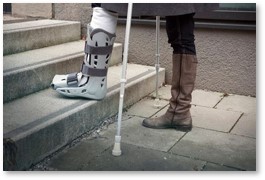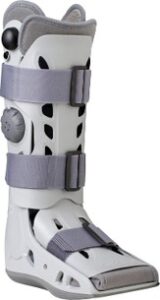My recuperation from ankle fusion surgery feels like it has gone on forever. I know this is not true because the operation took place on March 6. That means I have reached Week 7, past the half-way mark of a three-month recovery.
This Boot is Made for Walking
The surgeon told me I would be walking by the beginning of May and that’s true—sort of. I can walk now—sort of.
 The cast came off on Tuesday and was replaced with a removable orthopedic boot for the next four weeks of my recuperation. That means I can take the boot off to sleep, to shower, and just to sit around. Casts cannot be removed at any time.
The cast came off on Tuesday and was replaced with a removable orthopedic boot for the next four weeks of my recuperation. That means I can take the boot off to sleep, to shower, and just to sit around. Casts cannot be removed at any time.
Also, I can touch my foot to the ground, putting “partial weight” on it. I still have to use crutches or a walker to absorb the rest of my weight but this makes getting around easier and faster with less stress on my shoulders and other hip. The boot stays on for four weeks and I’m counting the days until May 19, when it’s scheduled to come off.
Although I no longer have to hop, I don’t really consider this “walking.” Not yet, anyway.
Returning Support Devices
In the meantime, we took some support devices back to the senior-center equipment rooms from which we borrowed them. In case you’re not aware, local senior centers have a room stocked with crutches, walkers, knee scooters, shower chairs and benches and other equipment to help when you’re recuperating from a procedure that limits your mobility.
It’s simple and cost-effective to borrow them and then return the equipment when you no longer need it. You can also donate equipment if you’re cleaning up a parent’s home or your own.
A Complicated Boot
 Like most of the equipment designed to help with recuperation, however, the boot could use some high-tech improvements. It feels very complex and somewhat clunky to me. One might liken it to part of an Imperial Stormtrooper’s armor, only heavier and more complicated.
Like most of the equipment designed to help with recuperation, however, the boot could use some high-tech improvements. It feels very complex and somewhat clunky to me. One might liken it to part of an Imperial Stormtrooper’s armor, only heavier and more complicated.
The boot comes in two pieces that have to be assembled and then fastened with stiff Velcro™ straps that tend to stick to one another. This doesn’t sound too bad on paper, and it’s really not bad when I’m getting dressed for the day. But I have to wear the boot whenever I’m upright. The occasional short trip to the bathroom at night means putting it together it in the dark.
My husband likens it to assembling an M-16 blindfolded and while leaning down at an awkward angle. The Velcro also makes a lot of noise, which your partner may not appreciate when trying to sleep. Five minutes later and back in bed, I have to reverse the process to remove it again.
I find this seriously annoying and try to minimize the trips by not drinking much in the evening. If an Imperial Stormtrooper had to go through this, he probably wouldn’t drink much, either. Maybe that explains their bad aim.
The Boot is the Boot
 I’m sure a young and non-disabled person, probably male, designed this boot to all the required specifications. This includes inflating pockets on three sides that you can increase with a pump and deflate with a button. The engineer probably found the dial easy to move. A senior citizen with arthritis in her hands disagrees.
I’m sure a young and non-disabled person, probably male, designed this boot to all the required specifications. This includes inflating pockets on three sides that you can increase with a pump and deflate with a button. The engineer probably found the dial easy to move. A senior citizen with arthritis in her hands disagrees.
I also think the boot is heavy because that’s the way it feels to me. Lugging it around all day makes me seriously tired.
While the boot comes in different shoe sizes, there is no women’s version that’s lighter and easier to assemble. The boot is the boot. After all, it if works for men, it should work just as well for women. Right? Because we all know that men are the standard all others must adjust to.
I make this complaint because I think that equipment for recuperating orthopedics patients has room for improvement. Any engineer who would like to make a lot of money can do so by designing something better, more convenient, easier to use, and female friendly. Opportunity knocks.
